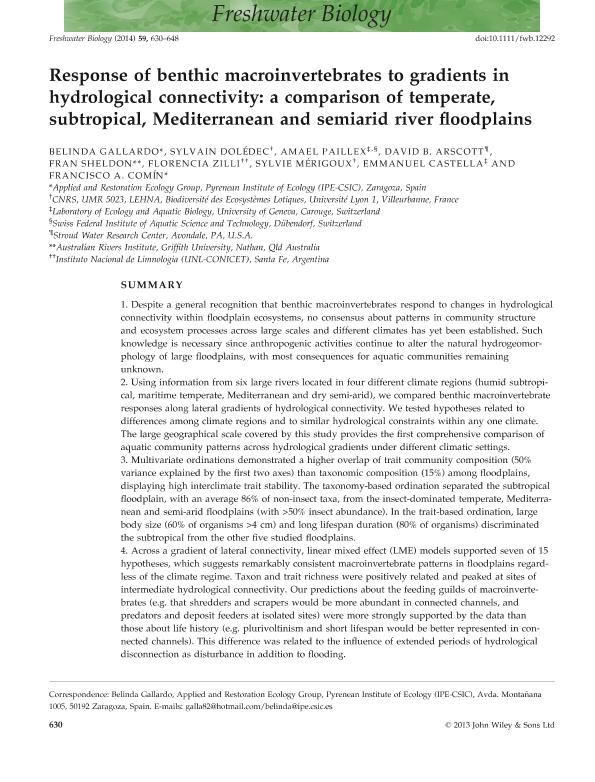Mostrar el registro sencillo del ítem
dc.contributor.author
Gallardo, Belinda
dc.contributor.author
Dolèdec, Sylvain
dc.contributor.author
Paillex, Amael
dc.contributor.author
Arscott, David B.
dc.contributor.author
Sheldon, Fran
dc.contributor.author
Zilli, Florencia Lucila

dc.contributor.author
Mérigoux, Sylvie
dc.contributor.author
Castella, Emmanuel
dc.contributor.author
Comín, Francisco A.
dc.date.available
2017-12-26T20:27:48Z
dc.date.issued
2013-12
dc.identifier.citation
Comín, Francisco A.; Castella, Emmanuel; Paillex, Amael; Dolèdec, Sylvain; Mérigoux, Sylvie; Zilli, Florencia Lucila; et al.; Response of benthic macroinvertebrates to gradients in hydrological connectivity: a comparison of temperate, subtropical, Mediterranean, and semiarid river floodplains; Wiley; Freshwater Biology (print); 59; 3; 12-2013; 630-648
dc.identifier.issn
0046-5070
dc.identifier.uri
http://hdl.handle.net/11336/31600
dc.description.abstract
1) Despite a general recognition that benthic macroinvertebrates respond to changes in hydrological connectivity within floodplain ecosystems, no consensus about patterns in community structure and ecosystem processes across large scales and different climates has yet been established. Such knowledge is necessary since anthropogenic activities continue to alter the natural hydrogeomorphology of large floodplains, with most consequences for aquatic communities remaining unknown.
2) Using information from six large rivers located in four different climate regions (humid subtropical, maritime temperate, Mediterranean and dry semi-arid), we compared benthic macroinvertebrate responses along lateral gradients of hydrological connectivity. We tested hypotheses related to differences among climate regions and to similar hydrological constraints within any one climate. The large geographical scale covered by this study provides the first comprehensive comparison of aquatic community patterns across hydrological gradients under different climatic settings.
3) Multivariate ordinations demonstrated a higher overlap of trait community composition (50% variance explained by the first two axes) than taxonomic composition (15%) among floodplains, displaying high interclimate trait stability. The taxonomy-based ordination separated the subtropical floodplain, with an average 86% of non-insect taxa, from the insect-dominated temperate, Mediterranean and semi-arid floodplains (with >50% insect abundance). In the trait-based ordination, large body size (60% of organisms >4 cm) and long lifespan duration (80% of organisms) discriminated the subtropical from the other five studied floodplains.
4) Across a gradient of lateral connectivity, linear mixed effect (LME) models supported seven of 15 hypotheses, which suggests remarkably consistent macroinvertebrate patterns in floodplains regardless of the climate regime. Taxon and trait richness were positively related and peaked at sites of intermediate hydrological connectivity. Our predictions about the feeding guilds of macroinvertebrates (e.g. that shredders and scrapers would be more abundant in connected channels, and predators and deposit feeders at isolated sites) were more strongly supported by the data than those about life history (e.g. plurivoltinism and short lifespan would be better represented in connected channels). This difference was related to the influence of extended periods of hydrological disconnection as disturbance in addition to flooding.
5) Trait stability across hydrological connectivity provides a meaningful ecological context for the comparison of the macroinvertebrate benthos among climatic zones, where taxonomic composition differs strongly. In addition, trait similarities and dissimilarities found in this study suggest that large-scale biogeographical filters do operate on communities, resulting in different trait combinations in temperate and Mediterranean floodplains when compared to semi-arid and subtropical environments. The extent to which global macroecological factors (i.e. climate, dispersal history) and local biotic and abiotic factors (i.e. drought frequency, habitat structure, water chemistry) contribute to this difference requires further investigation.
dc.format
application/pdf
dc.language.iso
eng
dc.publisher
Wiley

dc.rights
info:eu-repo/semantics/openAccess
dc.rights.uri
https://creativecommons.org/licenses/by-nc/2.5/ar/
dc.subject
River Habitat Templet
dc.subject
Paraná River
dc.subject
Tagliamento River
dc.subject
Rhône River
dc.subject
Ebro River
dc.subject
Murray River
dc.subject
Cooper Creek
dc.subject
Feeding Habits
dc.subject
Isolation
dc.subject
Intermediate Disturbance Hypothesis
dc.subject
Life History
dc.subject.classification
Otras Ciencias Biológicas

dc.subject.classification
Ciencias Biológicas

dc.subject.classification
CIENCIAS NATURALES Y EXACTAS

dc.title
Response of benthic macroinvertebrates to gradients in hydrological connectivity: a comparison of temperate, subtropical, Mediterranean, and semiarid river floodplains
dc.type
info:eu-repo/semantics/article
dc.type
info:ar-repo/semantics/artículo
dc.type
info:eu-repo/semantics/publishedVersion
dc.date.updated
2017-12-26T19:50:18Z
dc.identifier.eissn
1365-2427
dc.journal.volume
59
dc.journal.number
3
dc.journal.pagination
630-648
dc.journal.pais
Estados Unidos

dc.journal.ciudad
Hoboken
dc.description.fil
Fil: Gallardo, Belinda. Consejo Superior de Investigaciones Científicas; España. Instituto Pirenaico de Ecología; España
dc.description.fil
Fil: Dolèdec, Sylvain. Université Claude Bernard Lyon 1; Francia. Centre National de la Recherche Scientifique; Francia
dc.description.fil
Fil: Paillex, Amael. Universidad de Ginebra; Suiza
dc.description.fil
Fil: Arscott, David B.. Stroud Water Research Center; Estados Unidos
dc.description.fil
Fil: Sheldon, Fran. Australian Rivers Institute; Australia
dc.description.fil
Fil: Zilli, Florencia Lucila. Consejo Nacional de Investigaciones Científicas y Técnicas. Centro Científico Tecnológico Conicet - Santa Fe. Instituto Nacional de Limnología. Universidad Nacional del Litoral. Instituto Nacional de Limnología; Argentina
dc.description.fil
Fil: Mérigoux, Sylvie. Université Claude Bernard Lyon 1; Francia. Centre National de la Recherche Scientifique; Francia
dc.description.fil
Fil: Castella, Emmanuel. Universidad de Ginebra; Suiza
dc.description.fil
Fil: Comín, Francisco A.. Instituto Pirenaico de Ecología; España. Consejo Superior de Investigaciones Científicas; España
dc.journal.title
Freshwater Biology (print)

dc.relation.alternativeid
info:eu-repo/semantics/altIdentifier/url/http://onlinelibrary.wiley.com/doi/10.1111/fwb.12292/abstract
dc.relation.alternativeid
info:eu-repo/semantics/altIdentifier/doi/http://dx.doi.org/10.1111/fwb.12292
Archivos asociados
